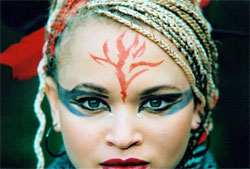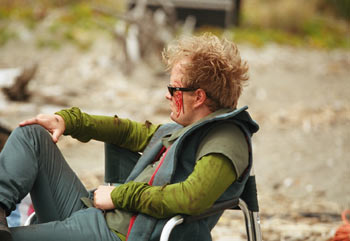 Whereas tanned skin used to be an attractive aesthetic indicating activity and good health, tanned skin has recently come to take on a negative connotation. Warning of sunburn, leathery skin, and even cancer compel us away from our parents’ childhood tactic of sitting in the sun just to tan and teach us the new rules of the street—Slip. Slop. Slap.
Whereas tanned skin used to be an attractive aesthetic indicating activity and good health, tanned skin has recently come to take on a negative connotation. Warning of sunburn, leathery skin, and even cancer compel us away from our parents’ childhood tactic of sitting in the sun just to tan and teach us the new rules of the street—Slip. Slop. Slap.
Slip on a long sleeved shirt
Slop on some sunscreen
Slap on a hat
But sunscreen is sticky, it’s stinky, and it’s—well isn’t that enough already?
What are the real effects of the sun? Is it as dangerous as our parents now warn, or are they passing on wives tales, the adult answer to urban legends? In other words….
Is the Sun a Force for Good or for Evil?
Inquiring minds want to know.
A Message from the Forces Against Sunlight
There are three strains of UltraViolet light: UVA, UVB, and UVC. Exposure to UVC affects you both temporarily and permanently. Short term effects, include a suntan or a sunburn or even an allergic reaction (often brought on by a conflict between antibiotics and the chemicals your body releases in response to sunlight). These short term consequences to exposure are early indicators of long term consequences, such as wrinkles, freckles, texture changes, and dilated blood vessels. And, oh yeah, skin cancer.
Which can be fatal.
There are millions of cases of skin cancer every year, many requiring only minor surgery, but tens of thousands of them are fatal.
The most common types of skin cancer are basal cell carcinoma, squamous cell carcinoma, and malignant melanoma. (Say that three times fast).
Carcinoma cancers tend to be relatively easy to spot. The cancer is manifested in a pale, waxy nodule, or in a red, scaly patch. As it is visibly and tangibly quite apparent, carcinoma is usually spotted and treated while still in its early stages.
Melanoma usually occurs on the extremities, and is manifested in pigmentation changes, for example the change in color, size, or shape of an existent mole, or a new area of dark pigmentation.
Both melanoma and carcinoma are treatable if spotted in time.
Although susceptibility to skin cancer is often born of habitual exposure to sunlight, your chances of skin cancer are doubled by having one bad sunburn. Yikes!
 The Rebuttal from the Forces For Sunlight
The Rebuttal from the Forces For Sunlight
Despite our preponderance for expunging ourselves from nature, humans are animals….And, in evolutionary terms, we (at least our bodies) are still outdoor animals.
If we are not exposed to enough sunlight, we can actually experience malillumination (think: malnutrition meets illumination, or light).
The dangerous UVC light mentioned above is actually only found in very small quantities in sunlight, and is much more common in tanning salons and halogen lights. The UV light in sunlight, in moderate portions, is important for maintaining muscle strength, energy, learning capacity, and even happiness.
In fact, UV light has even been found to benefit cancer patients! Dr. John Nash Ott has done extensive research on the biological effects of various spectrums of light, and has concluded that, UV radiation can be quite beneficial, and that the experiments linking cancer to sunlight were not extensive enough to be anywhere close to definitive.
However, mild exposure to sunlight has been definitively proven to reduce the risk of breast, colon, ovary, bladder, womb, stomach and prostate cancer.
And sunlight is our main source of Vitamin D. UVB light converts ergosterol (which is naturally found in our skin) to Vitamin D. Vitamin D is known to promote calcium absorption, giving us strong bones and a healthy nervous system.
Inadequate levels of Vitamin D can lead to autoimmune diseases such as Multiple Schlerosis and Rheumatoid Arthritis.
Our body’s pigmentation may actually be nature’s sunscreen. Melanin, the tanning pigment, is the right shade to protect us from sunlight in our geographic region (assuming we all stayed in once place!): darkest in equatorial regions, and gradually diminishing as the strength of sunlight diminishes.
Regardless of geography, a healthy suntan is often the best defense against sunburn.
Well? Which is it then?
If you are deciding between going goth and going to the beach…well we actually can’t help you there. But, a good rule to follow is:
 Everything in Moderation.
Everything in Moderation.
Sunglasses
Sunglasses are important because your eyeballs are actually highly susceptible to sunburn. Have you ever gone inside after a day in bright light, feeling like your eyes ached? You have experienced the short-term effects of UV radiation on your retinas. Like your skin, your eyes can receive long-term damage, which permanently alters your vision. Cataracts, near-sightedness, partial blindness…. These and more are the terrifying consequences you might experience if you do not take care.
Like pale skin, pale eyes are in greater danger than dark ones, putting blue eyes at the greatest risk for sunburn. Obviously you cannot slather sunscreen all over your eyes. However, one of your favourite fashion items can take up the slack.
Most sunglasses have lenses that block sunburn-causing UV radiation, acting to screen the damaging light from your eyes. They limit the spectrum of light able to enter your eyes, so that the dangerous light is not let in.
However, sunglasses are a delicate balance of good and evil—the positive trait described above can prove dangerous to the rest of your body.
So here’s the secret truth your momma didn’t share:
In addition to the part they play in your conscious life, your eyes are important sensors for your body’s automated responses. Your eyes tell both your mind and your body about your surroundings, and both your mind and your body react. When confronted with the FULL spectrum of Solar radiation, your eyes send stealthy messages to the rest of your body.
It goes a little something like this:
BODY: Eh! How’s the weather out there?
EYES: Eh! Sunny with a touch of clouds.
BODY: Oh! Better put on my sun-coat
….And your body adjusts your metabolism to prepare for exposure to the sun.
When you are wearing sunglasses, however, the eye-body stealth communication system sounds more like this:
BODY: Eh! How’s the weather out there?
EYES: Eh! Eh?? Ehh!?!? I can’t see anything!! It’s dark. Is anyone out there?
BODY: Calm down, eh? It’s just night.
….And your body adjusts your metabolism for no exposure to the sun.
 When your body is misinformed, it is not absorbing the healthy vitamins that can be taken from sunlight, nor is it making its own efforts to cope with the unhealthy radiation. In essence, the sun is able to unleash an attack while your body does not even know to defend itself.
When your body is misinformed, it is not absorbing the healthy vitamins that can be taken from sunlight, nor is it making its own efforts to cope with the unhealthy radiation. In essence, the sun is able to unleash an attack while your body does not even know to defend itself.
What is the healthy balance here? Do you wear sunglasses and protect your eyes from sunburn, while the rest of your body is burned? Or do you sacrifice your eyes to assist your body?
It is actually possible to protect your eyes and allow your body to adjust for the sunlight, simply by removing your sunglasses for 30 seconds every couple of minutes. Your body activates its defense systems but your eyes are not exposed long enough to be damaged.
Sunshine in The Tribe
In Tribeworld, as in our world, different cultures have different relationships with nature.
Rural and outdoorsy tribes such as the Eco-Tribe are quite directly exposed to the elements and to sunlight. They experience the rising and falling of the sun each day and night, in much the same way that a wild animal would.
The Urban tribes are, like any city-dwellers, much more removed from nature. Aggressive tribes such as the Locos are able to safely spend time outside. However, the more peaceful tribes have been forced into hiding, and a trip outside is a big trip indeed.
Is it any wonder that the Mallrats experienced habitiual bouts of depression when, for most of them, a trip outside was as rare as a new moon?
They are remembering to cover most of their basic necessities: food, water, and shelter. But they are letting their need for shelter overshadow their other needs. Very literally.

